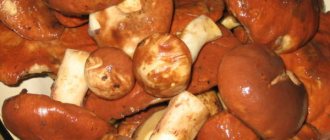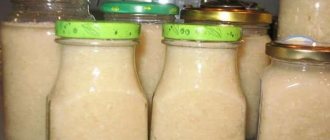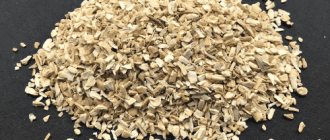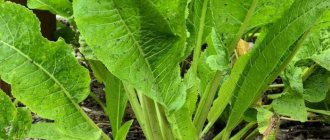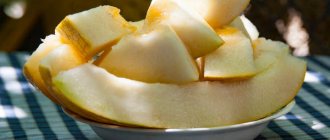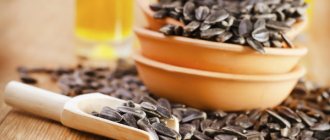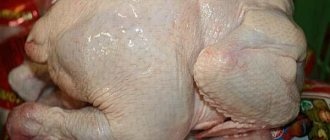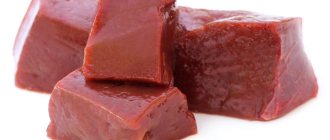The purpose of horseradish and its features
Horseradish is a perennial plant with thick roots and large leaves. The juice contains vitamins A, C, B1 and B2, and the root is also rich in mineral salts of potassium, magnesium, iron, phosphorus, etc. Horseradish has been grown in Russia since the 9th century. It is used not only in cooking, but also in folk medicine, as an antimicrobial agent; it helps with dysentery, all types of colds, toothache, physical and mental exhaustion.
All parts of horseradish contain essential oils with a pungent odor that awakens the appetite and causes tears when peeled and chopped.
Horseradish appears in recipes for preparing jellied meat, jellied fish, okroshka, and sauces. Kvass and the intoxicating drink Khrenovukha are prepared on its basis. The roots and leaves are used in home canning of mushrooms, cucumbers, tomatoes, and various assorted varieties. Chopped horseradish is added to sauerkraut.
Recipe for ginger sauce with horseradish (video)
This recipe is not only easy to prepare, but also has an amazing taste! Tips for choosing products:
- Give preference to firm sweet peppers ;
- It is better to take grape or apple vinegar ;
- You can add a little zest along . This way the sauce will sparkle with new shades of taste.
To prepare 6 servings you need:
- Yellow pepper (1-2 pcs.);
- Horseradish (1 root);
- Ginger (1 small root);
- Lemon (1/2);
- Vinegar (1 tablespoon);
- Salt, sugar (1.5 tablespoons each).
| Wash and peel the vegetables. Coarsely chop the pepper. |
| Cut the horseradish into 4-5 cubes, ginger into small circles. Add all this to the sweet pepper. |
| Pass through a meat grinder or finely grate. |
| Add a tablespoon of lemon juice, vinegar, salt and sugar. Mix thoroughly. |
In this video you can see in detail the entire preparation process:
How to store horseradish
There are several ways to preserve horseradish for future use:
- In the cellar. Dig up the roots, trim the leaves, shake off excess soil, but you don’t need to clean it all off. Place in boxes, layering with sand.
- In a refrigerator. Rinse the roots well, wrap in cling film or a regular plastic bag and store in the vegetable compartment.
- In the freezer. Wash and peel the horseradish, wrap in film and place in the freezer. This is the best way. Horseradish retains its taste and aroma, does not wither or rot. You just need to take it out and, without defrosting, grate it. There will be no tears, like when chopping fresh horseradish.
- Dried. The roots are washed, peeled, cut into thin slices and dried at a temperature of 40–50 degrees.
- In canned form. Peeled roots are pickled alone or mixed with other vegetables.
How to quickly and correctly peel the root
Since horseradish contains substances that cause tearing, it is necessary to initially prepare everything you need to clean it in order to reduce the accompanying discomfort. To do this, you need to take into account important nuances related to its preparation and the cleaning process itself.
When choosing horseradish, you should give preference to roots no more than 30-50 cm long and no less than 3-6 cm in diameter. The root crop is harvested in September.
Now let's look at how you can peel horseradish. As a tool for peeling horseradish root, you should stock up on the following kitchen utensils:
- a small sharp knife for cutting thin skin;
- special knife for peeling vegetables;
- a hard sponge for peeling young horseradish;
- kitchen towel or napkins.
Preparing for work
At this stage you need to perform only 2 actions:
- Take fresh horseradish root and put it in cold water, leave it there for 5-6 hours. If the vegetable is not fresh enough and has already begun to become woody, then it needs to be soaked for 3 days to a week. During this time, the peel, saturated with moisture, will become more elastic, which will help to easily remove dirt from it.
- At the end of this time, the horseradish root should be placed in the freezer for 2 hours; this procedure will help peel off the skin much faster when it freezes sufficiently and becomes more pliable.
Removing the peel
There are several ways to quickly and easily remove root skins, each with its own advantages and disadvantages.
Method 1. Peeling horseradish with a knife
Progress:
- After soaking the horseradish in water, it should be washed well under running water using a hard sponge or steel wool (some craftsmen use fine sandpaper), then cut off the protruding tendrils and deep dark spots in which soil accumulates.
- Remove excess moisture from the vegetable with a napkin.
- Using a knife, begin to remove the peel in thin strips, prying them at the base of the root, pulling them from top to bottom.
This method is good because everything is done quite carefully, and there are no scraps of peel lying around the workplace. On the other hand, by capturing the ribbons of skin, a significant part of the horseradish is also cut off.
Method 2: Peel using a paring knife
A paring knife is a special device consisting of a handle and an attached safety rectangular blade with a hole in the middle for peeling. It is also suitable for peeling horseradish root.
Progress:
- Wash the roots well under running water.
- Remove any remaining water with a napkin.
- Start scraping out the skin from the root using a paring knife.
This method has the advantage that less waste is produced than in the first method, but at the same time the workplace suffers - pieces of skin fly in different directions.
Note ! Preparation professionals believe that using a knife to peel horseradish root can be done much faster and more accurately with a little practice.
Method 3: Get creative with horseradish peeling
This method is suitable for peeling young horseradish whose peel has not yet become coarse enough. To do this you need to do the following:
- Wash small roots of young horseradish to remove the top layer of dirt.
- Using a sharp small knife, trim off all unnecessary parts: tendrils, dark places, limp and dried ends.
- Take an old toothbrush that has not been used for other household work and has not had contact with chemicals, and clean the roots with it under running water. Use a stiff brush to remove any remaining deep dirt from the small crevices of the spine.
If you have a Karcher mini-sink in your kitchen, then it will cope with the task even faster and will allow you to clean root vegetables without tears. A high-pressure stream of water will wash away any remaining soil and wash out the plant. To do this, you should place the roots, previously washed from the main dirt, in a mesh with small cells and only then start the wash.
Ways to clean horseradish, tools and equipment
By cleaning, you need to remove thin roots, areas damaged by pests or tools during digging, as well as the skin. If the root is young, the skin on it is thin and light, you don’t have to remove it, just wash it well. But on thick roots it has already hardened, become thick, has an unpleasant yellow or even brown tint, and must be removed.
The very first tool that comes to mind when you are going to peel horseradish is a knife. The thick root with a rough skin is peeled like a potato, and the thinner and more tender one is peeled like a carrot, scraping off only the thin top layer.
You can use a knife like this - cut off the peel with movements away from you
A universal cleaning tool is a metal dish brush. It can even remove scales from fish, and it can definitely handle horseradish.
To avoid injuring your hands on sharp wires, use a wire brush on the handle
If you haven’t bought a vegetable peeler yet, then the desire to quickly peel horseradish will be a strong argument in favor of purchasing one. This tool removes the skin in a thin layer and is not as dangerous to your hands as a knife.
Using a vegetable peeler is safer than using a knife
Savvy housewives even use a used toothbrush. It is desirable that the bristles be stiff.
When to peel horseradish
To prepare all kinds of dishes, the roots of this plant are most often grated or crushed using a meat grinder, blender, food processor, or juicer.
There is an opinion that horseradish should always be peeled to the white pulp, that is, the top layer should be completely cut off. This is not advisable: the peel contains a large amount of useful substances, so it is quite rational to leave part of it.
Root vegetables are always washed and cleaned, but they do it in different ways.
- If you are sure that the plant grew in good conditions, where the soil was not treated with chemicals, the root may not be completely cleaned. It will be enough to wash it well, remove thin roots and thickened areas, and also cut out nodules and those places where the most dirt has accumulated.
If you do not know in what conditions the plant grew, then it is better to remove the peel completely: pesticides, nitrates and other harmful substances accumulate in it.
- Thin young roots can not be cleaned at all, but simply washed in running water with a brush.
- If you are going to grate horseradish on a fine grater, it is advisable to peel it completely. The peel of large root vegetables is quite hard and clogs the holes in the grater, making work difficult. But if you are the lucky owner of a powerful food processor, you can clean root vegetables with minimal effort.
If you plan to grate horseradish, you need to peel it completely
- There is no need to completely remove the peel in cases where you plan to dry the root and then grind it into powder. Just wash it well using a brush.
- Horseradish for storing in the basement in winter along with other vegetables is not only not cleaned, but also not washed. You need to cut off the leaves, shake them off the ground and dry the roots in the fresh air during the day. After this, the horseradish is ready for wintering.
Horseradish does not need to be completely peeled
Horseradish sauce with cinnamon and cloves
- Horseradish (6-8 roots);
- Water (0.5 liters);
- Vinegar (55 g);
- Sugar (45 g);
- Salt (25 g);
- Cloves (4 pcs.);
- Cinnamon (1-2 teaspoons).
- As in previous recipes, we begin to peel the roots, and then chop them. Place the horseradish in a sterile jar.
- Now let’s start preparing the aromatic mixture: add salt and sugar to a saucepan with water. Heat until the first bubbles appear. Now is the time to add the cloves . Cook for another 3 minutes.
- When the liquid reaches room temperature, pour it into a deep bowl through a sieve or cheesecloth. Add a couple of teaspoons of cinnamon and 9% vinegar .
- Cover the mixture and let it sit for a day .
- Fill the jar with horseradish with the resulting mixture.
With beets
- Time: 1 hour 20 minutes.
- Number of servings: 5-7 persons.
- Calorie content of the dish: 56 kcal.
- Purpose: snack/condiment.
- Cuisine: Russian.
- Difficulty of preparation: easy.
Horseradish products are deservedly popular on the Russian table. This seasoning is healthy, has a specific aroma, and is indispensable for meat dishes. Making sauce with beets at home will help slightly soften the taste of the main component. Preparing the dressing is not difficult. A step-by-step recipe with photos will help you make the famous additive correctly.
Ingredients:
- vinegar (9%) – 2 tbsp. l.;
- granulated sugar – 1 tbsp. l.;
- beets – 100 g;
- horseradish – 200 g;
- water – 0.2 l;
- salt – 1 tsp.
- You need to start the cooking process by creating a marinade. Mix sugar, salt and vinegar in water. Place the contents of the pan on the fire, boil and cool.
- Beets need to be peeled and grated on a fine grater.
- The roots (one large horseradish) should be peeled and chopped using a blender or grater.
- Mix the prepared ingredients, pour warm marinade. Place into sterile containers and close. After waiting for the preserved food to cool, store it in the refrigerator.
We suggest you read: How to store horseradish for the winter
Khrenovukha
You will need : 3 liters of vodka, 150 g horseradish (roots), 1.5 tbsp. honey, 3-4 pcs. cloves, 3-4 pcs. peppercorns, zest of half a lemon.
Cooking . Wash the horseradish, peel and cut into pieces of arbitrary shape. Wash the lemon, dry it and grate the zest.
Place pieces of horseradish, lemon zest, cloves and pepper into a jar of vodka. Mix all ingredients. Then close the jar with a tight lid and place it in a dark, cool place for a week and a half. Keep in mind that the longer the horseradish brew is infused, the spicier the drink will be.
Take out the jar, add honey to it and stir well. Cover with a lid again and leave to infuse. In a week the drink will be ready for consumption.
Filter it and serve.
Culinary features
The smell of horseradish roots is sharp, fragrant and pungent. Comparable in pungency to chili peppers, horseradish has a complex flavor bouquet: initially sweetish with a burning aftertaste. The plant is actively used in Russian traditional cuisine for the preparation of pickled vegetables, sauces and seasonings.
In almost all cuisines of the world there is a plant that has the same properties as horseradish.
Horseradish serves as an excellent addition to any type of meat, fatty fish (salmon, trout, eel), various snacks, etc. Adding lemon juice and sugar to horseradish will significantly improve the taste of the seasoning, and sour cream and apples will soften the spiciness.
Horseradish is traditionally used for pickling cucumbers.
Alcoholic tinctures based on horseradish
This unusual alcohol-based drink was widely popular in Rus'. We offer several options for preparing tinctures based on honey and ginger.
Honey tincture (video)
A properly prepared drink will not cause a hangover. It has a light yellow hue with a sweet aroma.
- Horseradish (1-2 small roots);
- Honey (1 tablespoon)
- Vodka (500 ml);
- Lemon juice (2 tablespoons).
- pre-soaked in water , three . Place in a 1 liter jar.
- Add a spoonful of honey and lemon juice . Fill with alcohol .
- and stir every day .
- After 3 days, we pass the drink through cheesecloth and bottle it.
- Let it brew for another 2-3 days .
Vodka tincture with ginger
- Vodka (2500 ml);
- Horseradish (300-400 g);
- Ginger (150 gr);
- Honey (3 tablespoons)
- Cloves (5 dry buds).
- the peeled roots into 3-4 cm pieces
- Add cloves and honey to the horseradish. Pour vodka over all this.
- We put the jar in a dark place for 5 days .
- Strain the finished tincture, pour it, cover it with a lid and put it away for another couple of days.
Tincture “Kumivka” (hrenovukha) (video)
How to wash horseradish off your hands?
Horseradish is a vegetable with special substances that literally eat into the skin and tighten it. Horseradish can also cause a strong smell on your hands, so after preparing the vegetable you need to choose a method for competent and effective cleaning of your hands.
There are several methods that allow you to clean the remaining horseradish from your hands, remove all the vegetable juice and restore the softness of the skin. You can choose any method, and if necessary, you can combine several techniques:
- Lemon is perfect, rub it on your fingers and leave for 2-3 minutes to dissolve the remaining horseradish from your hands. Then wash your hands with warm water and mild soap. You can additionally lubricate your hands with your favorite cream to soften tight skin.
- You can use warm baths with added soap, in which your hands will be steamed for 10-15 minutes. After the procedure, you need to lubricate your hands with a nourishing cream to prevent dry skin.
Clean and smooth skin is guaranteed when using the correct cleaning method and following the correct technology.
